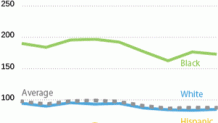Maureen Rubalcaba lost her six-week-old son Michael more than 20 years ago. Her heartache is still palpable.
"There is no other grief to compare to it," she said. "(The doctor) told us that he passed away. From that point I didn't return home."
Michael's cause of death was never determined, so it's a case of Sudden Infant Death Syndrome, or SIDS.
"It's the most common cause of death in infants between the ages of one month and one year," said Dr. Thomas Keens, a pediatrician at Children's Hospital Los Angeles and chairman of the California SIDS Advisory Council.
Keens fights to raise public awareness about SIDS.
"Sleeping on the stomach is probably the single highest risk factor," he said.
Local
Get Los Angeles's latest local news on crime, entertainment, weather, schools, COVID, cost of living and more. Here's your go-to source for today's LA news.
In Los Angeles County, a baby dies every week while sleeping, according to the county's Department of Public Health. Education and changes in behavior could prove lifesaving, but an important first step is doing a better job keeping track of these deaths.
The number of SIDS-related deaths has dropped substantially since the early 90s' "Back to Sleep" campaign led by the U.S. National Institute of Child Health and Human Development. Parents learned to put their babies on their backs at bedtime, removing loose bedding and toys. But since 2000, the number of infant deaths related to SIDS and suffocation has remained about the same.
"I know it's fun to have the cute bumpers and blankets, but it's not worth your baby's life," said Rachel Strickland, who lost her son Hayden before he turned 2 months. "Knowing that I would never hold him again, that was the worst moment and day in my life."
She advocates for more education about the risk factors.
The American Academy of Pediatrics just released its new report on SIDS and other sleep-related infant deaths, giving a detailed expansion of recommendations. It includes room sharing without bed sharing. That is, putting a crib or bassinet in the parents' bedroom for the first 6 to 12 months of life, offering their baby a pacifier and not feeding the baby on a couch or in an arm chair if the parent might fall asleep.
Assemblyman Kevin McCarty (D-Sacramento) believes an important part in getting the message out begins with collecting data.
"Having a statewide solution which brings about some focus to this issue can produce some real results," McCarty said. "It really is about information - when there is a tragedy, when a child dies — to figure out what happened, what the circumstances were."
His bill would fund child death review teams in every county in the state, modeled after one in Los Angeles which was the first in the country. Doctors, police officers, child protective service caseworkers come together to look at every infant death to try to determine the cause and then share their findings.
"Having the state have a coordinated system, having counties further step it up, I think would be better for public health and safety of little ones in California," McCarty said.

One data point we already know is black infants are dying at a rate two and a half times higher than white, Asian or Hispanic babies, with no biological explanation.
"It's a social, it's a political, it's an economic issue," said Rae Jones, executive director of Great Beginnings for Black Babies, a non-profit dedicated to funding services for black families. "If people are serious about infant deaths and reducing and impacting infant mortality then they have to make some serious investment in eradicating the problem."
For many who have suffered the consequences of SIDS, the pain never goes away.
"In the end, we all lost a child and we have that void," Rubalcaba said.



